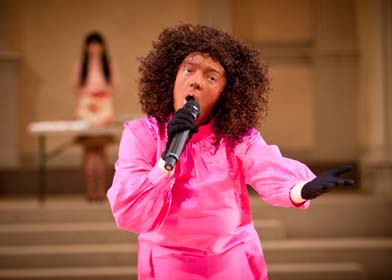|
Henry BaumgartnerThe Natives Are Restless TonightBlack Dance
"Black Dance" was the title of the evening's program, and yet none of the artists performing were "black" in the usual, African-American sense of the term. It seems that the evening's curator, Dean Moss, meant his title in the sense of "dance with an outsider sensibility," though I recall also hearing "black hearted" suggested by someone. The show was a one-time-only event, one of three consecutive nights curated by different artists, all part of Ishmael Houston-Jones's Platform 2012: Parallels. This is the latest in Danspace's series of platforms, whereby chunks of the season are given over to particular artists to program as they see fit. Houston-Jones is revisiting his project "Parallels" from 1982, which featured post-modern African-American choreographers, to examine what terms like "black," "African-American," or "outside the mainstream" might mean today. The artists onstage, of course, had their own ideas about what black dance might be. The first piece, "Hitting Video" from "Songs of the Dragons Flying to Heaven" by the celebrated theater artist Young Jean Lee, was a short video clip that was "black" because the camera had not been turned on. We did hear the sound, which consisted of a discussion about how to slap Lee along with the sound of slaps. When the video finally came on, there she was, looking at us, accompanied by what sounded like Korean classical music, complete with occasional percussive sounds at which she would flinch. Not uninteresting, but perhaps a bit slight. Similarly, Pedro Jiménez danced most of "SNooopy" in the dark; we heard him running about and yelping but could hardly make out his form. Eventually the lights came on, and he was descried running in circles around the space, stark naked, carrying a flag marked "Peace." The more substantial part of the evening was provided by Ann Liv Young's "Sherry Show." In tribute to the evening's theme, Young, as her ongoing character Sherry, appeared in blackface. Prancing about in a frizzy black wig and an absurd pink dress, she descended on various audience members in turn, asking them if they were black, or if not, what were they? As you might imagine, some people were a bit upset at all this, but Young stood her ground--in fact, she attacked with redoubled intensity wherever she sensed resistance, or even the lack of a totally cooperative spirit. (Your correspondent bravely cowered in the back row.) "Do you find what I'm doing offensive? Why? You're white, why did you come here? You look like you would hit women. Have you? I don't think you're telling me the entire truth." It's not as if these people were heckling her or anything of that sort; they were just sitting there quietly when they were suddenly swooped down upon. Eventually Young zeroed in on a woman who challenged her (about minstrel shows, I think--it was hard to hear); she started screaming at the woman, finally telling her to get out. She didn't, though. To finish up, Young sang a little song. Dance maybe or maybe not, and hardly African-American, but some kind of black, for sure. Some people clearly found the racial material offensive, but Young's relentless, inquisitorial cross-examination of the audience did have the merit of making us question such responses. Many Americans, even at this late date, are uncomfortable talking about race (me, too), and I thought Young's adamant refusal to be intimidated by the topic, let alone by what anybody thought of her (a Young specialty, this), was refreshing, and even, perhaps, wise. But there was something more going on. I felt like I was at one of those Maoist self-criticism sessions back in the Cultural Revolution. A performer is in a position of great power vis-à-vis an individual audience member, and to use this power to arrogantly browbeat innocent people is not acceptable. "I can draw the truth out of people," she boasted, and perhaps she can, but unoffending, innocent spectators have the right not to have any truth drawn out of them if they don't agree.
| lobby | search
| home | cue-to-cue |
discounts | welcome | film
| dance | reviews
| |
||


